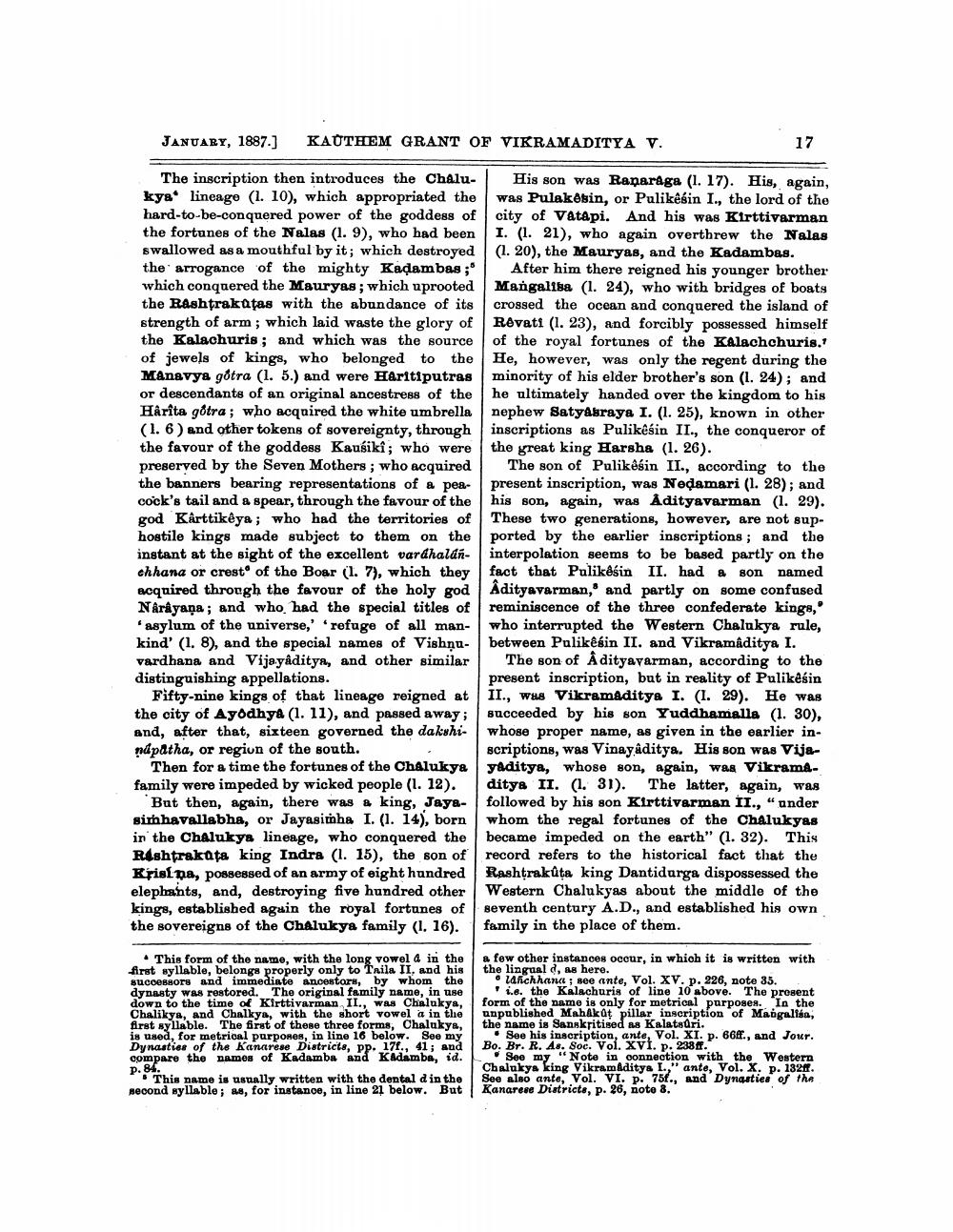________________
JANUARY, 1887.)
KAUTHEM GRANT OF VIKRAMADITYA V.
17
The inscription then introduces the Chalu- His son was Ranaraga (1. 17). His, again, kya* lineage (1. 10), which appropriated the was Pulakésin, or Pulikesin I., the lord of the hard-to-be-conquered power of the goddess of city of Vatapi. And his was Kirttivarman the fortunes of the Nalas (1.9), who had been I. (1. 21), who again overthrew the Nalas swallowed as a mouthful by it; which destroyed (1. 20), the Mauryas, and the Kadambas. the arrogance of the mighty Kaçambas; After him there reigned his younger brother which conquered the Mauryas; which uprooted Mangallba (. 24), who with bridges of boats the Rashtrakatas with the abundance of its crossed the ocean and conquered the island of strength of arm; which laid waste the glory of Rêvati (1. 23), and forcibly possessed himself the Kalachuris ; and which was the source of the royal fortunes of the Kalachchuris.' of jewels of kings, who belonged to the He, however, was only the regent during the Manavya gótra (1. 5.) and were Haritiputras | minority of his elder brother's son (1. 24); and or descendants of an original ancestress of the he ultimately handed over the kingdom to his Hârîta gotra; who acquired the white umbrella nephew SatyAbraya I. (1. 25), known in other (1. 6 ) and other tokens of sovereignty, through inscriptions as Pulikesin II., the conqueror of the favour of the goddess Kausikî; who were the great king Harsha (1. 26). preserved by the Seven Mothers; who acquired The son of Pulikesin II., according to the the banners bearing representations of a pea- present inscription, was Nedamari (1. 28); and cock's tail and a spear, through the favour of the his son, again, was Adityavarman (1. 29). god Kârttikêya; who had the territories of these two generations, however, are not suphostile kings made subject to them on the ported by the earlier inscriptions; and the instant at the sight of the excellent vardhaldn- interpolation seems to be based partly on the chhana or crest of the Boar (1. 7), which they fact that Pulikėsin II. had a son named acquired through the favour of the holy god Adityavarman, and partly on some confused Nárayana; and who had the special titles of reminiscence of the three confederate kings,
asylum of the universe,' refuge of all man who interrupted the Western Chalukya rule, kind' (1.8), and the special names of Vishnu- between Palikesin II. and Vikramaditya I. vardhana and Vijayaditya, and other similar The son of Adityavarman, according to the distinguishing appellations.
present inscription, but in reality of Pulikesin Fifty-nine kings of that lineage reigned at II., Wus Vikramaditya I. (I. 29). He was the city of Ayodhya (1. 11), and passed away; succeeded by his son Yuddhamalla (1. 30), and, after that, sixteen governed the dakshi- whose proper name, as given in the earlier inndpatha, or region of the south. . scriptions, was Vinayaditya. His son was Vija
Then for a time the fortunes of the Chalukya yaditya, whose son, again, was Vikramafamily were impeded by wicked people (1. 12). ditys II. (1. 31). The latter, again, was
But then, again, there was a king, Jaya- followed by his son Kirttivarman II., "ander simhavallabha, or Jayasimha I. (1. 14), born whom the regal fortunes of the Chalukyas in the Chalukya lineage, who conquered the became impeded on the earth" (1. 32). This R4shtrakata king Indra (1. 15), the son of record refers to the historical fact that the Krisi pa, possessed of an army of eight hundred Rashtrakuta king Dantidurga dispossessed the elephants, and, destroying five hundred other Western Chalukyas about the middle of the kings, established again the royal fortunes of seventh century A.D., and established his own the sovereigns of the Chalukya family (1. 16). family in the place of them.
• This form of the name, with the long vowel & in the first syllable, belongs properly only to Trila II, and his AUCOebsors and immediate ancestors, by whom the dynasty was restored. The original family name, in use down to the time of Kirttivarman II., was Chalukya, Chalikya, and Chalkyą, with the short vowel a in the first syllable. The first of these three forms, Chalukya, is used for metrionl purposes, in line 16 below. See my Dynasties of the Kanarese Districts, pp. 178., 41; and compare the damos of Kadamba and Kadamba. id.
This name is usually written with the dental d in the necond syllable; as, for instance, in line 21 below. But
a few other instances occur, in which it is written with the linguald, as here. • canchhana ; see ante, Vol. XV. p. 226, note 35.
i.e. the Kalachuris of line 10 above. The prosent form of the name is only for metrical purposes. In the unpublished MahAkut pillar inscription of Mangulisa, the name is Sanskritised as Kalatsuri.
See his inscription, ante, Vol. XI. p. 668., and Jour. Bo. Br. R. As. Soc. Vol. xvi. p. 238ff.
See my, "Note in connection with the Western Chalukya king Vikramaditya L.," ante, Vol. X. p. 132ff. See also ante, Vol. VI. p. 75., and Dynasties of the Kanarese Districts, p. 26, note 8.
p. 84.




